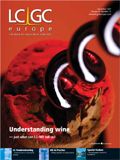Ex-tech-10 and HTC-10
The Tenth International Symposium on Hyphenated Techniques in Chromatography and Chromatographic Analysers (HTC-10) will be held in Bruges, Belgium, from 30 January to 1 February. The event commemorates 20 years of dissemination of scientific knowledge in the field.
The Tenth International Symposium on Hyphenated Techniques in Chromatography and Chromatographic Analysers (HTC-10) will be held in Bruges, Belgium, from 30 January to 1 February. The event commemorates 20 years of dissemination of scientific knowledge in the field.

HTC-10 will again cover all the fundamental aspects, instrumental developments and applications of the various hyphenated chromatographic techniques (e.g., coupling of GC or LC to LC, GC and SFC/SFE; MS, FTIR, AED and other techniques coupled with GC, HPLC, SFC, CZE, CEC and FFF; PTV–GC–MS; on-line air traps-, purge- and trap, extractorsand GPC–GC (or LC); LC to NMR, Raman, FIA–DAD, light scattering; ITP–MS etc.). Emphasis will also be placed on sample introduction, miniaturization, micro-fabricate analytical devices and on the design of hyphenated, on-line and at-line chromatographic analysers.
ExTech-10 is a symposium series highlighting new extraction technologies for chemical and biochemical analysis in laboratory and on-site settings. The general focus is on solvent free sample preparation including methods for rapid and selective enrichment prior to analysis and micro-sample preparation. Major emphasis will be placed on the fundamental understanding of extraction processes that result in greater selectivity and efficiency in method development, and a rationalization of method selection for specific applications. On-site environmental methods and biomedical applications will be covered. The 2008 edition will focus especially on passive sampling methods, use of molecular imprinted polymers, biologically modified sorbents, novel coatings and sorbent materials.
Additionally, on Wednesday 30 January, a special one day conference on Public Safety and Security emphasizing the Hyphenated Chromatographic approach will be held. On this day, both the sample preparation problems and the analytical methodologies developed for the continuing public protection will be discussed. This symposium will highlight new sampling, sample-preparation, derivatization, sample-introduction and hyphenated chromatographic techniques for forensic research and for the detection and analysis of chemical and biological warfare agents and their degradation products.
From Wednesday 30 January until Friday 1 February, there will also be a large integrated exhibition of scientific posters and commercial instrumentation, consumables and services.
Additional information on the exhibition can be obtained from htc@ordibo.be
March 2008
Pittcon 2008
New Orleans, Louisiana, USA
Pittcon 2008 will be held at the Morial Convention Centre in New Orleans from 1–7 March.
The world's largest conference and exposition for laboratory science will showcase all the latest products and technologies, offer practical technical knowledge and provide a stage for global networking opportunities.
For more information visit http://www.pittcon.org/
28–30 January 2008
Microfluidics and Nanofluidics 2008,
Grande Oasis, Cancun, Mexico
Contact: Jonathan Slater, Zing Conferences,
40 Leys Avenue, Cambridge, CB4 2AW, UK
tel: +44 78 33 191 957
e-mail: jonathan.slater@zingconferences.com
website: www.zingconferences.com/
micronanofluidics
9 –13 March, 2008
msb2008 — 22nd International Symposium on Microscale Bioseperations and Methods for Systems Biology, organized by the ISAS —Institute for Analytical Sciences, with
support from Freie Universität Berlin
Berlin, Germany
Contact: msb2008 Symposium Office
ISAS — Institute for Analytical Sciences, Bunsen-Kirchhoff-Str. 11, 44139 Dortmund, Germany
tel: +49 231 1392 254
fax: +49 231 1392 300
e-mail: info@msb2008.org
1 –4 April, 2008
Analytica 2008,
Fairground Munich, Germany
Contact: Messe München GmbH, Messegelände, 81823 München, Germany
Tel: +44 89 949 11488
fax: +44 89 949 11489
e-mail: info@analytica.de
10 –16 May, 2008
32nd International Symposium on High Performance Liquid Phase Separations and Related Techniques
Baltimore Marriott Waterfront Hotel
Baltimore, Maryland, USA
Contact: Ms Janet Cunningham, Symposium/Exhibit Manager
E-mail: janetbarr@aol.com
Send your event details to cbuckett@advanstar.com
Regulatory Deadlines and Supply Chain Challenges Take Center Stage in Nitrosamine Discussion
April 10th 2025During an LCGC International peer exchange, Aloka Srinivasan, Mayank Bhanti, and Amber Burch discussed the regulatory deadlines and supply chain challenges that come with nitrosamine analysis.
Polysorbate Quantification and Degradation Analysis via LC and Charged Aerosol Detection
April 9th 2025Scientists from ThermoFisher Scientific published a review article in the Journal of Chromatography A that provided an overview of HPLC analysis using charged aerosol detection can help with polysorbate quantification.














